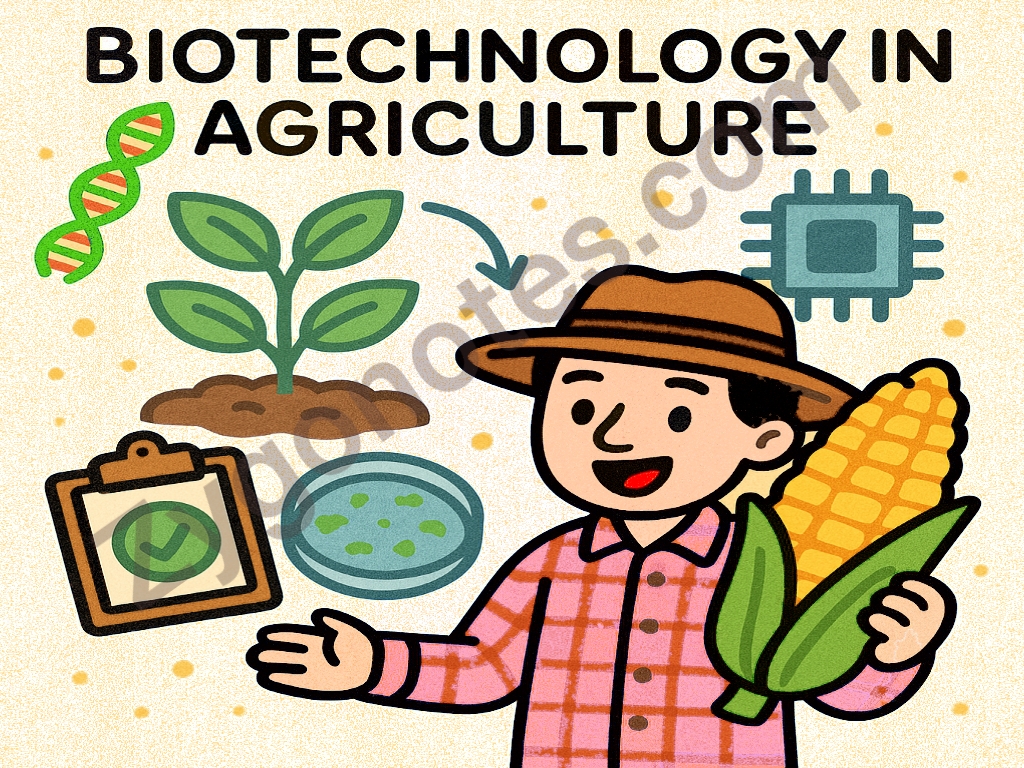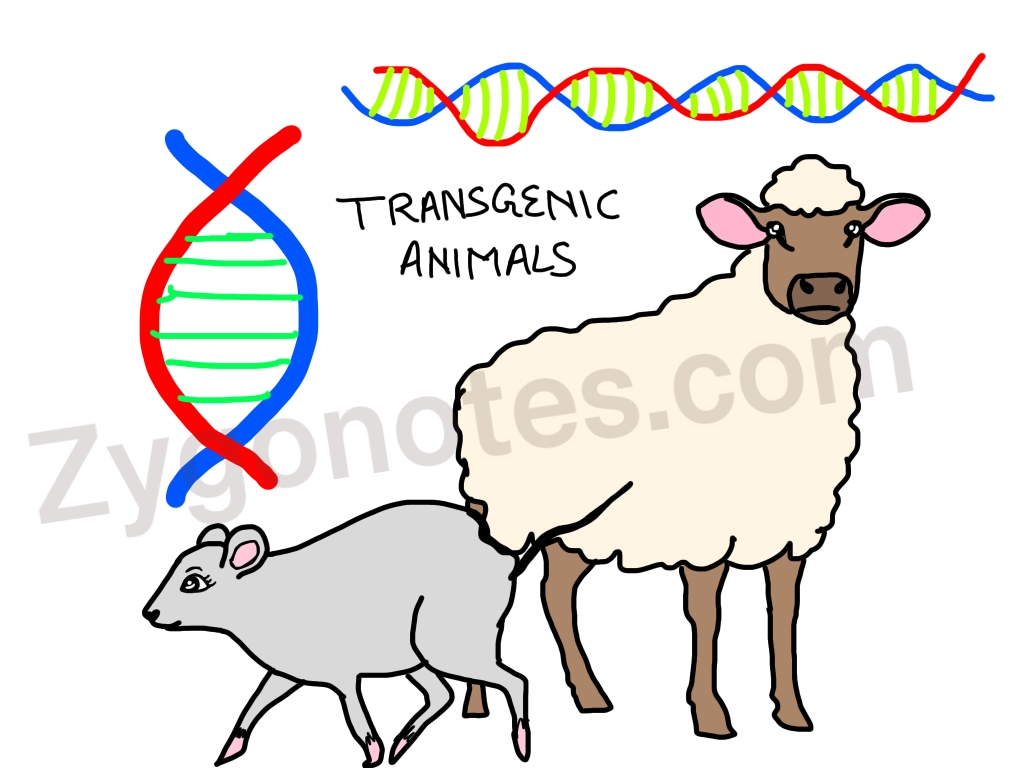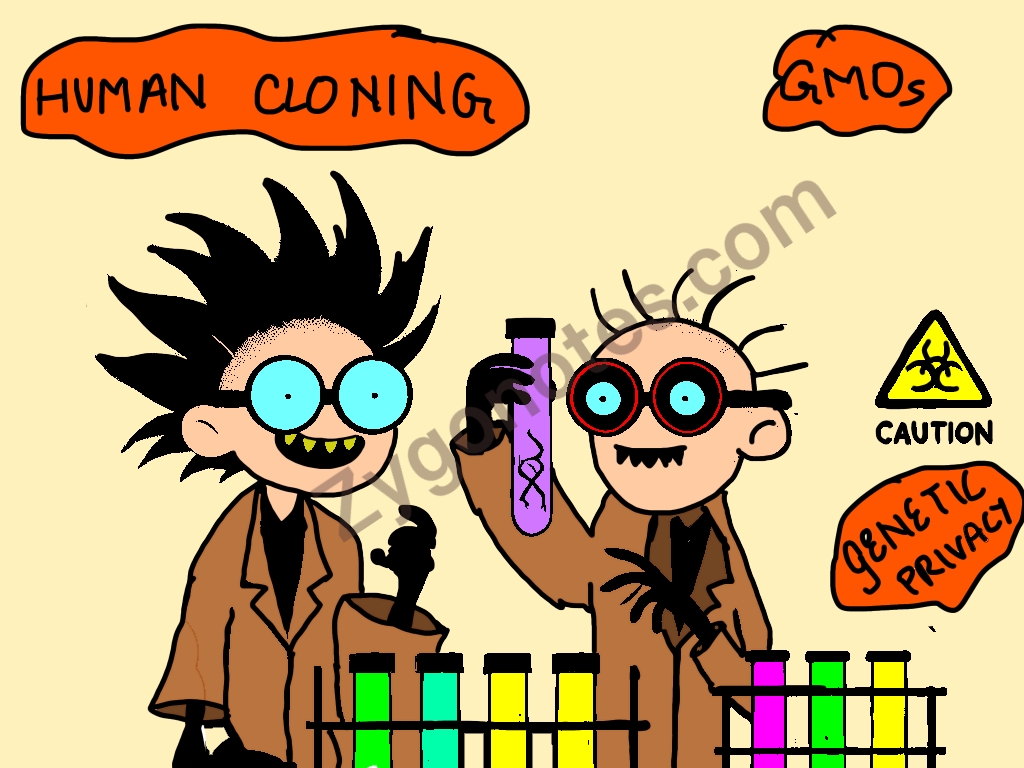1. Biotechnology Applications in Agriculture
Biotechnology plays a significant role in agriculture by enhancing crop productivity, developing pest-resistant plants, and improving food quality. Through genetic engineering, specific genes are introduced into plants to enhance their desirable traits. This process allows the development of genetically modified (GM) crops, which offer improved yield, resistance to pests and diseases, and tolerance to environmental stresses such as drought or salinity.
One of the most significant applications of biotechnology in agriculture is the creation of herbicide-resistant crops. For example, transgenic crops such as glyphosate-resistant soybean and glufosinate-resistant maize allow farmers to use herbicides without harming the crops, reducing the need for excessive tillage and preserving soil quality.

Another major innovation is the development of drought-tolerant crops through genetic engineering. These plants can survive with minimal water supply, which is particularly beneficial in arid regions. Additionally, biotechnology is used to create crops with enhanced nutritional value, such as golden rice, which is fortified with vitamin A to combat malnutrition.
Biotechnology also facilitates the production of bio-pesticides and bio-fertilizers, which are eco-friendly and reduce chemical pesticide dependency. Furthermore, through tissue culture techniques, disease-free and high-yielding plants are propagated rapidly.
Overall, biotechnology in agriculture offers sustainable solutions by improving crop resilience, reducing environmental impact, and ensuring food security, which is crucial for meeting the demands of a growing population.
2. Advantages of Genetic Modification in Plants
Genetic modification (GM) in plants offers several advantages, making it a revolutionary technology in modern agriculture. The primary benefit is the enhanced resistance to pests and diseases. By introducing specific genes, plants can produce their own insecticidal proteins, reducing the need for chemical pesticides. For instance, Bt cotton contains genes from Bacillus thuringiensis, making it resistant to bollworm infestation.
GM crops also exhibit herbicide tolerance, allowing farmers to control weeds effectively without damaging the crops. This reduces the cost and effort required for weed management. Additionally, genetically modified plants have increased tolerance to environmental stresses such as drought, salinity, and extreme temperatures, ensuring stable yields under adverse conditions.
Another major advantage is the improved nutritional quality of GM crops. For example, Golden rice, engineered to contain higher levels of vitamin A, helps combat vitamin A deficiency in developing countries.
Furthermore, GM plants contribute to higher productivity and reduced crop loss, ensuring better food security. They also have a longer shelf life due to delayed ripening, reducing post-harvest losses.
Finally, genetic modification allows the development of phytoremediation plants that can clean up environmental pollutants by absorbing heavy metals from contaminated soils, offering an eco-friendly solution to pollution control.
3. Pest-Resistant Plants
Pest-resistant plants are genetically engineered to withstand attacks from harmful insects and pests, reducing the dependency on chemical pesticides. This is achieved by introducing insecticidal genes into the plant’s genome, enabling it to produce proteins that are toxic to specific pests.
The most common example is Bt crops such as Bt cotton, Bt maize, and Bt brinjal. These plants contain genes from Bacillus thuringiensis (Bt), which produce Cry proteins. These proteins bind to receptors in the gut of the insect, causing cell lysis and ultimately killing the pest. Bt cotton is particularly effective against bollworms, while Bt maize resists corn borers.
The benefits of pest-resistant plants include:
- Reduced pesticide usage, minimizing chemical residues in the environment.
- Lower production costs, as farmers spend less on pest control.
- Enhanced crop yield and quality due to decreased pest damage.
- Environmental safety, as Bt crops target specific pests without affecting beneficial insects.
However, continuous use of pest-resistant plants can lead to insect resistance, reducing their effectiveness. To combat this, farmers are encouraged to practice refuge planting (growing non-Bt plants alongside Bt crops) to delay resistance development.
Pest-resistant plants are a major breakthrough in biotechnology, promoting sustainable farming practices, lowering chemical pesticide dependency, and increasing agricultural productivity.
4. Nematode Resistance in Tobacco Plants
Nematodes are parasitic worms that cause significant damage to crops by feeding on plant roots, stunting growth and reducing yield. Biotechnology offers a solution by engineering nematode-resistant plants through the application of RNA interference (RNAi) technology.
In tobacco plants, scientists introduced specific genes to silence the expression of vital nematode genes. This is achieved by inserting DNA segments corresponding to the nematode’s target gene into the plant. When nematodes feed on the plant, the introduced RNA triggers the degradation of nematode mRNA, preventing the production of essential proteins required for their survival.
The effectiveness of RNAi-based resistance was first demonstrated in tobacco plants to combat the Meloidogyne incognita nematode. These transgenic tobacco plants showed reduced nematode infestation, better root health, and improved growth.
The benefits of nematode-resistant plants include:
- Reduced crop loss due to nematode infection.
- Decreased dependency on chemical nematicides, promoting eco-friendly farming.
- Enhanced soil quality, as fewer chemicals are applied.
Nematode resistance through biotechnology is a sustainable approach to protecting crops, improving yields, and reducing environmental impact.
5. Genetically Engineered Insulin
Genetically engineered insulin is a significant advancement in biotechnology for managing diabetes mellitus. Traditionally, insulin was extracted from pancreas of pigs and cattle, which posed risks of allergic reactions and limited supply. The advent of recombinant DNA technology revolutionized insulin production.
In this process, the human insulin gene is inserted into the plasmid of Escherichia coli or Saccharomyces cerevisiae (yeast). The genetically modified bacteria or yeast synthesize proinsulin, which is then processed into human insulin. This synthetic insulin, known as Humulin, is chemically identical to human insulin and has minimal side effects.
The advantages of genetically engineered insulin include:
- Large-scale production at a lower cost.
- Reduced risk of allergic reactions compared to animal-derived insulin.
- Higher purity and consistency, ensuring better efficacy.
- Lower risk of contamination and easier purification.
Recombinant insulin has improved the quality of life for diabetic patients by providing a safer, more reliable treatment option. It has also paved the way for future biopharmaceutical innovations.
6. Gene Therapy
Gene therapy is a revolutionary biotechnology technique aimed at treating genetic disorders by correcting defective genes. It involves introducing, removing, or altering genes within an individual’s cells to treat or prevent diseases.

There are two types of gene therapy:
- Somatic gene therapy – Targets body cells and does not pass the modifications to offspring.
- Germline gene therapy – Targets reproductive cells, making the changes inheritable.
One successful application is in the treatment of Severe Combined Immunodeficiency (SCID). Patients with SCID lack functional immune systems due to a defective ADA gene. In gene therapy, the normal ADA gene is introduced into the patient’s white blood cells, restoring immune function.
Gene therapy is also being explored for treating cystic fibrosis, hemophilia, and some cancers. However, challenges such as immune reactions, ethical concerns, and the potential for unintended genetic changes remain significant.
7. Molecular Diagnosis
Molecular diagnosis is a biotechnological technique used to detect diseases at the molecular level by identifying specific DNA, RNA, or proteins. It provides accurate, early, and precise disease diagnosis.
Techniques involved in molecular diagnosis include:
- Polymerase Chain Reaction (PCR): Amplifies specific DNA sequences to detect pathogens, making it useful for identifying infections like HIV and tuberculosis.
- ELISA (Enzyme-Linked Immunosorbent Assay): Detects antigens or antibodies, aiding in the diagnosis of viral diseases.
- DNA fingerprinting: Used in forensic science and paternity testing.
Molecular diagnosis offers:
- High accuracy and sensitivity.
- Early disease detection, improving treatment outcomes.
- Genetic disorder screening, enabling preventive care.
8. Transgenic Animals

Transgenic animals are genetically modified organisms with foreign genes introduced into their genome. These animals are used in research, agriculture, and medicine.
For example:
- Transgenic mice are used to study cancer and human diseases.
- Transgenic sheep and goats produce therapeutic proteins in their milk.
- Transgenic cows with improved milk quality and disease resistance.
Transgenic animals benefit medical research, offering models for human diseases and testing new drugs. They also aid in producing pharmaceutical proteins and enhancing livestock productivity.
9. Ethical Issues in Biotechnology

Biotechnology raises several ethical concerns, including genetic privacy, human cloning, and GMOs. Ethical debates revolve around tampering with nature and the potential for unforeseen consequences.
Issues include:
- GM crops: Concerns over their long-term effects on health and the environment.
- Gene therapy and editing: Fear of misuse for human enhancement.
- Animal welfare: Ethical concerns over transgenic animals used in research.
Ethical regulations ensure responsible use of biotechnology, balancing innovation with safety.